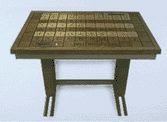

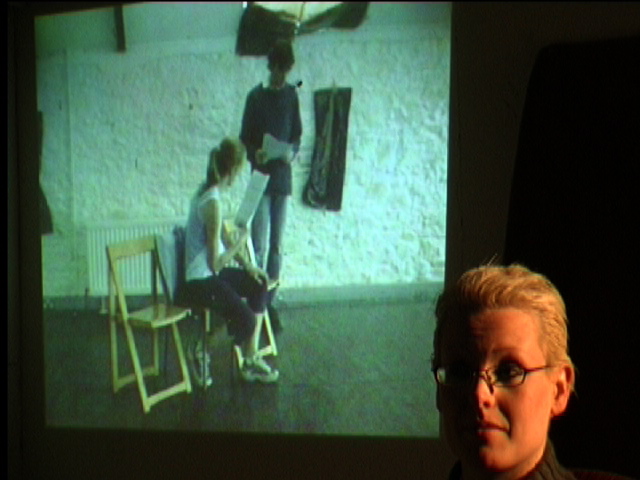
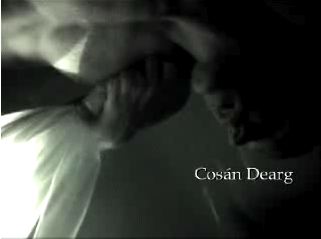
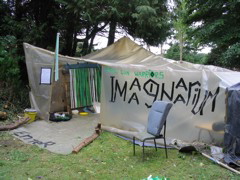

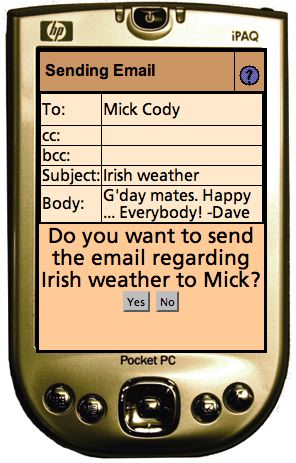
Sola Grantham, Erin Panttaja, Kimiko Ryokai, Justine Cassell
Gesture and Narrative Language Group
MIT Media Laboratory
CrossTalk is an interactive keyboard designed to allow two or more people to play with language and communication in a social setting. It was designed as part of the emergent Literary Salon project.
Traditionally, a cafe is a place where people go to hear poetry, talk with friends, meet new people, or just read and have a cup of coffee with the murmur of conversation in the background. Today's CyberCafes, however, mostly encourage visitors to communicate with people on distant sides of the world or to play engrossing computer games on their own, while largely ignoring the possibilities of social interaction among those people who are co-present. The Literary Salon is a cafe setting in which the tables function both as traditional tables and as ways to communicate with other people in the same physical space, enhancing and enabling face-to face social interactions, rather than detracting from them.
CrossTalk is a table which integrates two large keyboards, one maple and one mahogany. The two keyboards are interlaced (see accompanying photo), to form the top of a flat table. Interactants stand on either side of the table and simultaneously compose messages by typing on the hand-sized keys. This highly tactile medium requires the two participants to negotiate a shared physical space while typing their messages.
As they type, they also encounter the shared medium of sound. Each key produces a different word, murmured by one of two different voices. This allows the participants to collaborate in the creation of conversational background sounds.
Once a message is composed and sent, it travels along a visual channel of small flashing lights. In this medium of transition, movement is highlighted. The message can be seen only briefly as it passes by on a moving LED sign.
The text then alights upon a display screen, where each letter visually carries with it the shadow of a word; this is the same word that echoed aurally when the letter key was pressed. As the message forms on this screen, these temporary words fade away and leave a colorful record of the previous messages.
A primary goal of this project is to encourage people to play with language. The most straightforward way of using the table is to type in messages and then send them across the channel to the LED display and the large screen. However, there is a second way to play with the table. Rather than creating words out of letters, participants can try to compose utterances out of aural word sounds. For example, a participant may type the letters c-y-d-h-j-?. This results in the sounds, "Can you do high jump, hmmm?". So while the channel displays only the letters, "CYDHJ?" the people near the table hear a transient utterance which makes sense. In addition, when the letters reach the output display, each briefly carries with it the whole word, so once again the message has transient meaning. In either mode, the users may be cooperative in creating conversations or stories, or may be antagonistic, in the form of speed contests or verbal games.
Another goal is to create a feeling of community within the cafe. The table itself is a conversational piece. Its characteristic appearance encourages people to approach it, and the very fact that it is unusual and beautiful means that people are more likely to interact around it. Once someone is playing with CrossTalk, it makes conversational sounds, potentially including everyone within audible range in the set of participants. In addition, the screens on which messages are displayed are large enough that they can easily be seen from across the room, bringing still more people into the interaction. Even someone sitting on the other side of the room may occasionally catch a glimpse of a message as it goes by on the LED sign, and, because the channel is visible, they will be able to trace this message both forward to its recipient and backwards to its sender.
The CrossTalk table is 117 cm by 80 cm and 82 cm tall. Each key is a square 9 cm on each side. Letters on the maple and mahogany keys were carved using a laser cutter. A MicroChip PIC processor inside of the table is programmed to interpret each keypress and send it to a hidden computer via a serial line. The software is written in Java 1.1.4 and runs on a Microsoft Windows NT machine. The system requires four serial ports and a pair of speakers. Text is displayed in full view of participants on an LED sign, 1 m long by 14 cm tall, and a 160 x 120 cm projection screen with a resolution of 600 by 800.